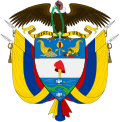| This article is part of a series on the |
| Politics of Colombia |
|---|
 |
Presidential elections were held in Colombia on 1 May 1938. [1] Eduardo Santos of the Liberal Party was the only candidate after the Conservative Party decided not to contest the elections, and received 100% of the vote. [2] [3] Voter turnout was only 30.2%. [2] Santos took office on 7 August. [4]